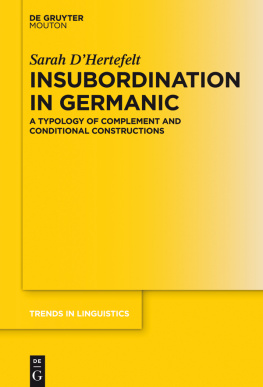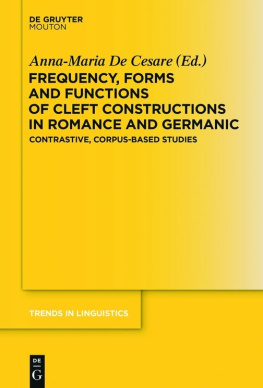Contents
Guide

Sarah DHertefelt
Insubordination in Germanic
Trends in Linguistics Studies and Monographs

Editor
Volker Gast
Editorial Board
Walter Bisang
Jan Terje Faarlund
Hans Henrich Hock
Natalia Levshina
Heiko Narrog
Matthias Schlesewsky
Amir Zeldes
Niina Ning Zhang
Editor Responsible for this volume
Volker Gast and Niina Ning Zhang
Volume 318

ISBN 978-3-11-054663-7
e-ISBN (PDF) 978-3-11-054868-6
e-ISBN (EPUB) 978-3-11-054666-8
ISSN 1861-4302
Library of Congress Cataloging-in-Publication Data
A CIP catalog record for this book has been applied for at the Library of Congress.
Bibliographic information published by the Deutsche Nationalbibliothek
The Deutsche Nationalbibliothek lists this publication in the Deutsche Nationalbibliografie; detailed bibliographic data are available on the Internet at http://dnb.dnb.de.
2018 Walter de Gruyter GmbH, Berlin/Boston
www.degruyter.com
Acknowledgements
There are a number of people without whom this book would not exist in its present form. It is my pleasure to thank all of these people for their help, input and support.
First and foremost, I would like to express my deep gratitude to my former supervisor, Jean-Christophe Verstraete, for the confidence he has shown in me, and for the incredible amount of time and energy he devoted to reading, commenting on and discussing this work. In addition, my sincere thanks go to An Van linden, my former co-supervisor, for her critical readings of this study, and for her enthusiasm and warmth.
I am grateful to Liesbeth Degand, Hendrik De Smet and Ad Foolen for their detailed and insightful comments on the entire manuscript. I further thank Hendrik for his help with various corpus-related questions and issues. I am also indebted to Volker Gast, editor of the Trends in Linguistics / Studies and Monographs series, and an anonymous reviewer, for valuable feedback on this work, and for directing me to a number of additional studies. In addition, I would like to thank Kirstin Boergen, Nancy Christ and Julie Miess for guiding me through the publication process.
For their native speaker insights and valuable feedback on earlier parts of this study, I thank Tanya Karoli Christensen, Sune Snderberg Mortensen and Eva Skafte-Jensen for Danish, Marit Julien, David Petersson, Henrik Rosenkvist and Anna-Lena Wiklund for Swedish, and Sigrur Mjll Bjrnsdttir, ris Edda Nowenstein and Brynhildur Stefnsdttir for Icelandic. For additional native speaker insights in Leuven, I gratefully acknowledge the help of Sara Gabrielsson for Swedish, Nima Moshgbar for German, and Arnds Gunnarsdttir and Sigfs Sigmundsson for Icelandic. I further thank Ronny Boogaart, Pedro Gras and Bill McGregor for their stimulating comments on previous presentations relating to this work.
The research for this project was supported by project GOA/12/007, funded by the Research Council of the University of Leuven. For financial support of my research stay in Copenhagen and Lund, I would like to thank Academische Stichting Leuven .
A heartfelt thanks goes out to all my former colleagues at the university of Leuven. Finally, I would like to thank my family(-in-law) for always supporting me in every possible way and for being such a wonderful team. An extra special word of thanks goes out to Wouter, for making me happy every single day.
Abbreviations
Corpora
| CGN | Spoken Dutch Corpus |
| IC | Personal corpus of internet material |
| DGD | Database of spoken German |
| GSLC | Gteborg Spoken Language Corpus |
Symbols
| # | (pragmatically) unacceptable |
| * | ungrammatical |
| obsolete |
Glosses
| 2 | second person |
| I, II | gender I, II |
| ATTR | attributive |
| CNJ | conjunctive |
| COBL | complementizing oblique |
| COMP | complementizer |
| COND | conditional |
| CONT | continuative |
| CONV | converb |
| CTR | control transitive |
| DAT | dative |
| DEF | definite |
| DEM | demonstrative |
| DU | dual |
| ERG | ergative |
| F | feminine |
| HEARSAY | hearsay |
| HORT | hortative |
| IMMED | immediate |
| IMP | imperative |
| IND | indicative |
| INDP | independent pronoun |
| INF | infinitive |
| INFM | infinitival marker |
| INTERJ | interjection |
| IPFV | imperfective |
| IRR | irrealis |
| LINK | link |
| LOC | locative |
| MDL | middle |
| N | neuter |
| NAME | proper name |
| NEG | negation |
| NOM | nominative |
| NOMLZ | nominalization |
| PART | partitive |
| PASS | passive |
| PFV | perfective |
| POT | potential |
| PPART | past participle |
| PROP | proprietive |
| PRT | particle |
| PRS | present |
| PST | past |
| PURP | purposive |
| QUOT | quotative |
| R | coreferential |
| REFL | reflexive |
| REL | relative marker |
| RESTR | restricted |
| SBJ | subject |
| SBJV | subjunctive |
| SG | singular |
| SS | same subject |
| ST | stative aspect |
| SUBORD | subordinative |
| TAG | tag |
1Introduction
This study explores the category of insubordination using a corpus of Germanic material. As defined by Evans (2007: 367), insubordination is the conventionalized main clause use of what, on prima facie grounds, appear to be formally subordinate clauses. Some Germanic examples of insubordinate structures are given in (1) to (3). All of these structures have the basic characteristics of subordinate clauses in Germanic, in that they are introduced by a subordinating conjunction and have a specific subordinate word order in German and Dutch, but they are used independently, i.e. without an accompanying main clause, to express for instance a feeling of resentment as in (1), a wish as in (2), or a threat as in (3):
| (1) | English |
| Hell go with us to the hospital. Okay? As if I had a choice. |
| (Brinton 2014a: 99) |















